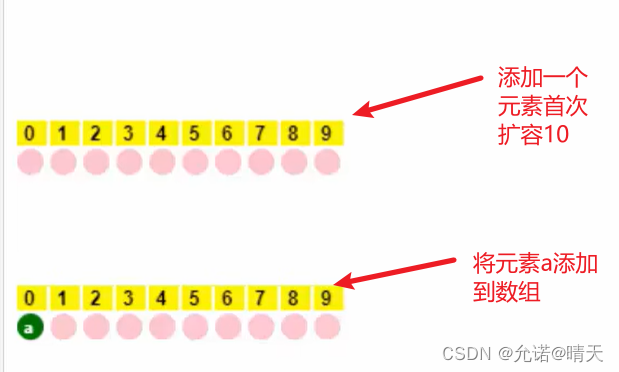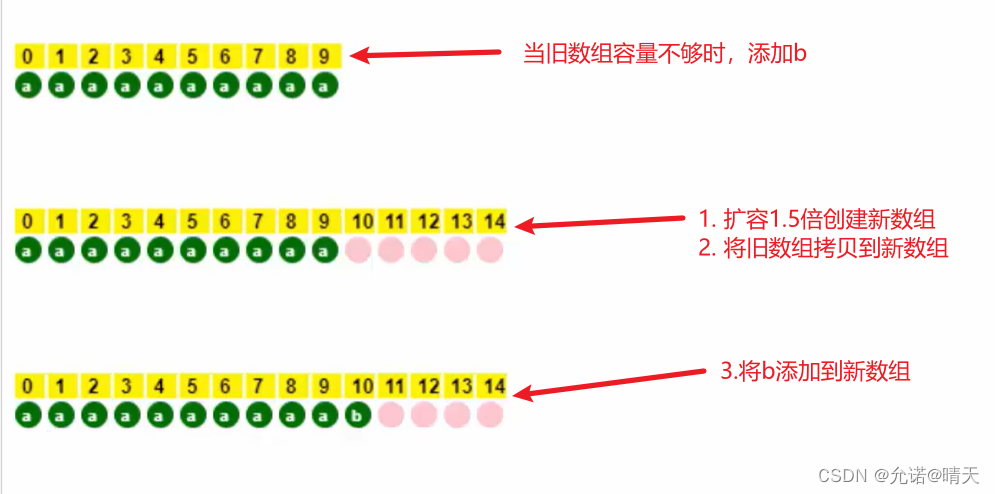文章目录
引言
要注意的是,以下所有代码中用反射方式来更直观地反映 ArrayList 的扩容特征,但从 JDK 9 由于模块化的影响,对反射做了较多限制,需要在运行测试代码时添加 VM 参数
--add-opensjava.base/java.util=ALL-UNNAMED方能运行通过
扩容规则
1. ArrayList() 无参构造扩容
ArrayList() 无参构造会使用长度为零的数组
ArrayList()源码
/**
* Constructs an empty list with an initial capacity of ten.
*/
public ArrayList() {
this.elementData = DEFAULTCAPACITY_EMPTY_ELEMENTDATA;
}
2. ArrayList(int initialCapacity)扩容
ArrayList(int initialCapacity) 使用指定容量的数组初始化ArrayList()
ArrayList(int initialCapacity)源码
/**
* Constructs an empty list with the specified initial capacity.
*
* @param initialCapacity the initial capacity of the list
* @throws IllegalArgumentException if the specified initial capacity
* is negative
*/
public ArrayList(int initialCapacity) {
if (initialCapacity > 0) {
this.elementData = new Object[initialCapacity];
} else if (initialCapacity == 0) {
this.elementData = EMPTY_ELEMENTDATA;
} else {
throw new IllegalArgumentException("Illegal Capacity: "+
initialCapacity);
}
}
3. public ArrayList(Collection<? extends E> c) 扩容
public ArrayList(Collection<? extends E> c) 会使用 c 集合 的大小作为数组容量
ArrayList(Collection<? extends E> c) 源码
/**
* Constructs a list containing the elements of the specified
* collection, in the order they are returned by the collection's
* iterator.
*
* @param c the collection whose elements are to be placed into this list
* @throws NullPointerException if the specified collection is null
*/
public ArrayList(Collection<? extends E> c) {
Object[] a = c.toArray();
if ((size = a.length) != 0) {
if (c.getClass() == ArrayList.class) {
elementData = a;
} else {
elementData = Arrays.copyOf(a, size, Object[].class);
}
} else {
// replace with empty array.
elementData = EMPTY_ELEMENTDATA;
}
}
4. add(Object o)扩容
add(Object o) 首次扩容为 10,再次扩容为上次容量的 1.5 倍(使用移位相加的规则即 (原容量 > > 1 ) + 原容量 (原容量>>1)+ 原容量 (原容量>>1)+原容量 )
无参构造ArryList()
-
首次添加元素a

-
当数组容量满时添加b

代码演示:
演示扩容10次的ArrayList的长度
import java.util.ArrayList;
import java.util.List;
public class TestArrayList {
public static void main(String[] args) {
System.out.println(arrayListGrowRule(10));
}
private static List<Integer> arrayListGrowRule(int n) {
List<Integer> list = new ArrayList<>();
int init = 0;
list.add(init);
if (n >= 1) {
init = 10;
list.add(init);
}
for (int i = 1; i < n; i++) {
init += (init) >> 1;
list.add(init);
}
return list;
}
}
// 执行结果:[0, 10, 15, 22, 33, 49, 73, 109, 163, 244, 366]
5. addAll(Collection c) 扩容
addAll(Collection c) 没有元素时,扩容为 Math.max(10, 实际元素个数),有元素时为 Math.max(原容量 1.5 倍, 实际元素个数)
代码演示:
- 无初始容量时扩容
import java.lang.reflect.Field;
import java.util.ArrayList;
import java.util.List;
// --add-opens java.base/java.util=ALL-UNNAMED
public class TestArrayList {
public static void main(String[] args) {
testAddAllGrowEmpty();
}
private static void testAddAllGrowEmpty() {
ArrayList<Integer> list = new ArrayList<>();
list.addAll(List.of(1, 2, 3));
// list.addAll(List.of(1, 2, 3, 4, 5, 6, 7, 8, 9, 10, 11));
System.out.println(length(list));
}
public static int length(ArrayList<Integer> list) {
try {
Field field = ArrayList.class.getDeclaredField("elementData");
field.setAccessible(true);
return ((Object[]) field.get(list)).length;
} catch (Exception e) {
e.printStackTrace();
return 0;
}
}
}
//当执行 list.addAll(List.of(1, 2, 3)); 时运行结果为:10
//当执行 list.addAll(List.of(1, 2, 3, 4, 5, 6, 7, 8, 9, 10, 11)); 时结果为:11
- 有初始容量(10) 时扩容
import java.lang.reflect.Field;
import java.util.ArrayList;
import java.util.List;
// --add-opens java.base/java.util=ALL-UNNAMED
public class TestArrayList {
public static void main(String[] args) {
testAddAllGrowNotEmpty();
}
private static void testAddAllGrowNotEmpty() {
ArrayList<Integer> list = new ArrayList<>();
for (int i = 0; i < 10; i++) {
list.add(i);
}
list.addAll(List.of(1, 2, 3));
// list.addAll(List.of(1, 2, 3, 4, 5, 6));
System.out.println(length(list));
}
public static int length(ArrayList<Integer> list) {
try {
Field field = ArrayList.class.getDeclaredField("elementData");
field.setAccessible(true);
return ((Object[]) field.get(list)).length;
} catch (Exception e) {
e.printStackTrace();
return 0;
}
}
}
//当执行 list.addAll(List.of(1, 2, 3)); 时运行结果为:15
//当执行 list.addAll(List.of(1, 2, 3, 4, 5, 6, 7, 8, 9, 10, 11)); 时结果为:16





















 1017
1017











 被折叠的 条评论
为什么被折叠?
被折叠的 条评论
为什么被折叠?








